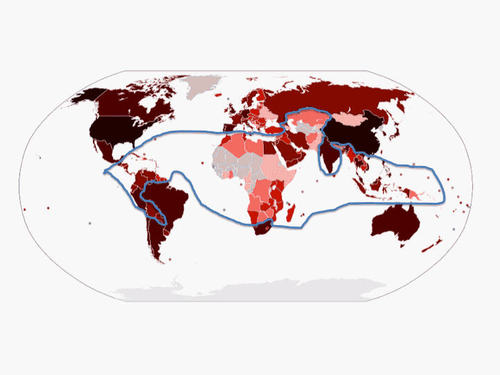The death-rate prediction isn't holding on H1N1, unless my math is really bad
 Sunday, October 25, 2009 at 6:19AM
Sunday, October 25, 2009 at 6:19AM ARTICLE: Families say flu scare comes with a dose of craziness, By Donna St. George, Washington Post, October 25, 2009
ARTICLE: Back where virus started, new scrutiny of pig farming, By David Brown, Washington Post, October 25, 2009
Thinking back to the presidential study that I wrote about in Esquire:
Half of America contracts H1N1? That one seems on target.
But the 30k (low)-versus-60k (mid)-versus 90k (high) death rates for this season?
Obama declares a national emergency on 100 or so child deaths and 1000 overall and we're already past the alleged peak of 15 Oct, which now is being moved back by many experts (as the "wave" keeps expanding). Plus, those totals seem to draw upon deaths going back across the entire year vice just this fall wave (tell me if I'm wrong, because I haven't yet found a good timeline of deaths in the U.S.).
Again, on the spread, I'm buying it, but the death rate just isn't there. At this rate, the numbers would suggest we get our usual 25k-30k with seasonal and a slight bump with H1N1, but not one anyone would have noticed absent the news--unless 1k through the end of October somehow increases 30-to-50 fold over the next 3-4 months (which would certainly impress me). Docs are saying the current high spread is mostly H1N1, but also some of another strain, presumably less important/more normal.
Is my math all wrong on this? Because unless we see thousands dying per week, I don't see how even the low total (roughly equal to seasonal, so a doubleplusbad overall season) is possible.
A day after the piece was published, I'm in with my regular doc getting a physical for international adoption purposes, and he says it'll all be a lot of wasted motion--the H1N1 effort, because the death totals will be miniscule and we'll look back in hindsight and say, "Could we have made a better effort on something elsewhere?"
As a security guy, I'd still stick with the logic that says, "Take it as a dry run for something truly bad, as any practice is good practice." I mean, check out the map and see that H1N1 has spread, just like most quick-spreading things, far more heavily in the Core than in the Gap (no big surprise, as Gap has only 1/3rd of humanity, plus that much less connectivity/reporting/travel). So, again, it's worth practicing against.
Especially since all that rising connectivity in the Core means more and more mixing (from the pig farming cite above):
What worries virologists is the mixing of human and swine flu strains -- or, worse, human, swine and bird strains. That can lead to "reassortment," in which strands of genetic material are exchanged to yield a new virus, often with behavior not seen in its parents. Those features can include higher contagiousness, rapid growth, the ability to infect the lungs and, most important, an unfamiliar appearance to the immune system.
Reassortment is rare, and it is even rarer when the product is a strain that can spread like wildfire. That is one reason influenza pandemics occur only a few times a century. (The last one was in 1968.)
But, having said all that, Dr. (No) Bullington is looking pretty accurate for now.
Having written the piece because it seemed sensible to take a presidential study seriously, my natural skepticism now kicks in on the long-term impact. Why? Same as with Y2K and all "peak" freak-out projections: the predictions on the interdependence and connectivity all seem logical enough, but the assumptions of system fragility leading to death rates/instability are overblown. Why? I guess we're just not as clueless and fragile as experts think.
But, as always, there's the element that says, "Better to warn and overwhelm with effort and swim past with relative ease than simply sit back and think it all works out."
It's just that, in the end, I think we're going to have to admit that this whole thing ends up proving more resilience than vulnerability, for all the usual reasons.
I know we like to freak out, and I'm sure there's some evolutionary advantage, but there are also solid reasons why we've grown so numerous and dominant as a species.













Reader Comments (5)
I wonder if TARP even made a difference at all, besides restoring Wall Street bankers wealth. Everybody said it was GOING to be bad, but TARP saved us all from a grand depression. I think not.
So, here we are with an H1N1 pandemic that is a bit less lethal then the seasonal flu, yet we are declaring a national emergency. Call it practice, or call it crying-wolf, but soon we're all going to tune out.
Now, all of a sudden, we have the "Media Flu" (H1N1) which certainly is a virus we should be concerned with. Not so much for the symptoms it causes but that it exists! For the first time (?) we are confronted with TWO "Seasonal" Flus . . and with globalization and world travel, this can only get worse . . unless the world decides to spend as much on virology as it has spent on the Global Warming Hoax . . And that would be a far better expenditure for the Human race in the long run . .
That last part hits the nail on the head. There is a reporting bias here, as the gap lacks medical surveillance systems and really doesn't know what they have, be it dengue or H1N1.
But that's means it's just another form of--or lack thereof--connectivity. The more info flows, the more discrete it is.